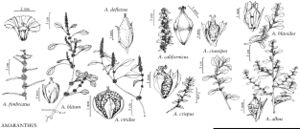Amaranthus albus
Syst. Nat. ed. 10, 2: 1268. 1759.
Plants annual, glabrous or glabrescent or viscid-pubescent. Stems usually erect, ascending proximally, rarely almost prostrate, much-branched, bushy (large plants forming tumbleweeds), 0.1–1 m. Leaves: petiole 1/2 as long as blade, or longer in young proximal leaves; blade obovate to narrowly spatulate, mostly 0.5 × 0.5–1.5 cm, early proximal leaves to 8 cm, base tapering, narrowly cuneate, margins entire, plane (or ± distinctly undulate), apex obtuse, with whitish or yellowish, subspinescent mucro. Inflorescences axillary glomerules, green, whitish green, or yellowish. Bracts of pistillate flowers subulate to linear-lanceolate, narrow, 2–3 mm, 2 times as long as tepals. Pistillate flowers: tepals 3, narrowly ovate to linear, slightly unequal, 1–1.5 mm, thin, apex acute; style branches erect; stigmas 3. Staminate flowers intermixed with pistillate; tepals 3; stamens 3. Utricles ellipsoid-ovoid, 1.5 mm, equaling or exceeding tepals, smooth proximally, coarsely rugose distally, dehiscence regularly circumscissile. Seeds dark reddish brown to black, lenticular, 0.6–1 mm diam., shiny.
Phenology: Flowering summer–fall.
Habitat: Disturbed habitats, waste places, vacant areas, railroads, streambanks, sandy areas, roadsides, agricultural fields
Elevation: 0-2200 m
Distribution
Introduced; St. Pierre and Miquelon, Alta., B.C., Man., N.B., Nfld. and Labr., N.S., Ont., P.E.I., Que., Sask., Ala., Alaska, Ariz., Ark., Calif., Colo., Conn., Del., D.C., Fla., Ga., Idaho, Ill., Ind., Iowa, Kans., Ky., La., Maine, Md., Mass., Mich., Minn., Miss., Mo., Mont., Nebr., Nev., N.H., N.J., N.Mex., N.Y., N.C., N.Dak., Ohio, Okla., Oreg., Pa., R.I., S.C., S.Dak., Tenn., Tex., Utah, Vt., Va., Wash., W.Va., Wis., Wyo., Mexico, introduced and often successfully naturalized in South America, Eurasia, Africa, Australia.
Discussion
The name Amaranthus graecizans, which refers to a species of Old World origin, has been misapplied to both A. albus and A. blitoides in earlier North American floras and manuals.
Southwestern plants differing from typical Amaranthus albus in having viscid pubescence and usually distinctly crisped leaf margins may be recognized as var. pubescens; they were occasionally treated as a separate species, A. pubescens.
Amaranthus albus and A. blitoides are rather often confused in herbaria. The species are easily distinguished by their seed size and luster.
Selected References
None.
